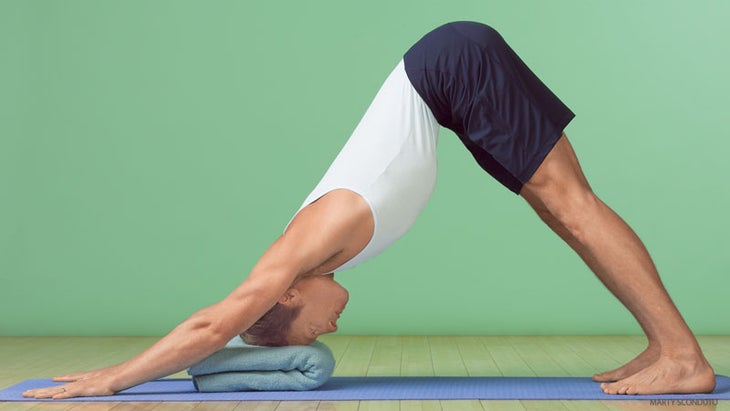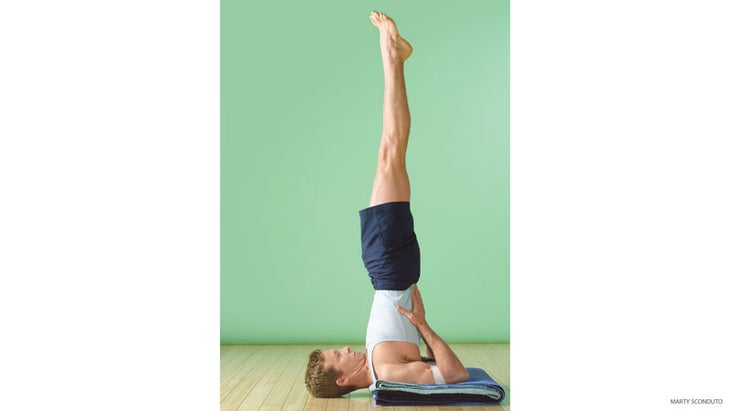Heading out the door? Read this article on the new Outside+ app available now on iOS devices for members! Download the app.
Yoga props reeducate and still the mind by awakening the body’s intelligence.
Yoga is a complex subject with this very simple definition: yogah cittavrtti nirodhah (the Yoga Sutra, I.2), which translated means, “Yoga is the cessation of movements in the consciousness,” according to B.K.S. Iyengar in his book Light on the Yoga Sutras of Patanjali. Yogis divide consciousness (citta) into three parts: mind, ego, and intelligence. In his book, Light on Life, Iyengar compares these constituent parts to layers. The outermost layer is the mind. It is responsible for sifting through all of the information it receives through the five senses, as in “I’m hungry” or “I’m cold.” Because the mind constantly generates thoughts and images, Iyengar likens it to a computer that can’t stop itself from processing, or drawing distinctions, or making considered choices.
The ego is the innermost layer of consciousness. It is what gives us the sense of our separateness, or “I-ness,” and the feeling that we are at the center of everything. The ego is valuable because it is important to know that you are not the stranger sitting next to you on the bus or the tree in your front yard. But the ego has earned a negative reputation because it also holds on to all desires, achievements, prejudices, and opinions and identifies itself as being the sum total of any successes, worries, possessions, jobs, and whatever else that one has amassed. The ego clings to life and often lives in its glorious past or in the fearful future.
In between the mind and the ego lies the middle layer, intelligence. The distinguishing characteristics of intelligence are its capacity to perceive itself and its ability to choose to do something it hasn’t done before. In other words, intelligence is the part of our consciousness that enables us to objectively observe ourselves (including the mind and ego) and initiate change. Iyengar describes intelligence as “the revolutionary of our consciousness.”
Iyengar says that when one layer of consciousness is active, it expands, causing the other layers to retract. So when we activate our intelligence, we force the overactive mind and clinging ego to recede, giving us the experience of stillness that is yoga.
The Importance of Yoga Props
Most of us think the physical brain is the only place where intelligence and perception occur. But Iyengar says that view devalues the innate intelligence of the body—the yogi’s vehicle on the path to stilling the consciousness. He insists that intelligence can be cultivated in every cell of the body. One of the methods he has developed for expanding intelligence is to use props while practicing asana.
The skin is our first layer of intelligence, and the nerves in the skin feed information to the mind, Iyengar says. Since an average square inch of skin contains more than a thousand nerve endings, when a prop touches the skin, our consciousness is awakened and enlivened. Intelligence is developed not because we feel something but because we can observe where the prop touches us and where it doesn’t, and in what way the prop teaches us something new. “Every prop must make an imprint on the body,” Iyengar says, so that intelligence can be cultivated. There is no purpose to using a prop if we don’t learn something from it.
Stilling the fluctuations in our consciousness is a relentless, difficult, and demanding discipline. Therefore, fervor, or tapas, is essential if one wishes to progress along the path of yoga. Iyengar says that tapas ignites the lamp of intelligence and that it is the duty of the guru to ignite the fire in each of his students and to shed the light of intelligence where there is darkness or ignorance. He likens props to gurus, meant to guide the student on the path. “Real gurus are rare and do not come often,” he says. When the guru is not there in person, props can be used to guide the practitioner toward correct action and maximum intelligence. When used in this way, props can engage us in a process of observation, discernment, and reflection. This process will expand our intelligence and begin to teach us how to still the fluctuations of our consciousness.
See also6 Yoga Props to Boost Your Practice
Yoga Prop Sequence

1. Adho Mukha Svanasana (Downward-Facing Dog Pose)
Place a folded blanket on the floor and come onto your hands and knees. Place your hands on either side of the blanket as shown above, so they are shoulder-width apart and the middle fingers point straight ahead. Lift your knees off the floor and adjust your feet so that they are hip-width apart. Straighten your arms and legs. Rest your head on the blanket. If your head does not touch the blanket, either build up the height of support under your head or move your feet farther away from your hands. Stay for 1 to 3 minutes. Repeat the pose without the blanket and notice any differences. Compare the stretch of the legs and the extension in the spine when your head is supported and when it is not. Observe whether the arms and legs stretch better when the head rests on a support.
While you are in the pose, study yourself. It is easy to feel the places that are in contact with the floor or that are stretching. Use your intelligence to penetrate the places where you have no awareness. Iyengar says that while we are in the pose we must study the pose, not merely stay in it. Recharge the pose by pressing the hands into the floor. This will intensify the stretch of the legs. Be sure that both sides of the torso are in line and are the same length as the center of the torso. Observe where your intelligence recedes.

2. Salamba Sarvangasana (Supported Shoulderstand)
Place a neatly folded stack of three blankets on the floor. Make a loop in a belt that is large enough so that when you slip it on your arms just above the elbows, the elbows are in line with your shoulders. Don’t make the loop too small or too large. Place the belt around the arms just above the elbows. Lie on your back with your shoulders on the blankets and head on the floor (your neck should not be on the blankets). As you lie there, notice where the belt touches the arms. Does the belt touch both arms in the same place and in the same way? Lift your legs up to come into Shoulderstand. Place your hands on your back. Keep your legs straight. Do not turn your head while in the pose.
According to Iyengar, the belt is used in this pose to educate the skin and muscles of the arm. It is not used as a support, nor does it stabilize the arms and keep them from moving apart. The feedback from the belt should give you answers to questions such as: Where does the belt touch each arm? Where do I feel the belt? Where don’t I feel the belt? Is one arm pulling toward the belt? If the belt feels different on each arm, which arm is doing the correct action?
Use the feeling of the belt against the arms to constantly adjust your pose. The biceps should rotate from the inside out. The more you turn the biceps out, the more the shoulder blades go up. When you come out of the pose, look to see whether the belt left a mark on your arms. It shouldn’t have. If a mark is there, it is an indication that your arm was pressing against the belt. The next time you practice the pose, see if you can correct the action in that arm.

3. Utthita Trikonasana (Extended Triangle Pose)
Stand facing a dining table or the back of a sofa. Separate your feet. Turn the right foot in slightly and turn the left leg out so that the left foot is parallel to your prop. Stretch your arms out to the side and, keeping the legs straight, move the left hand to the floor and stretch the right arm up. Observe the muscles in your upper back. Do you feel thickness in the trapezius muscles? (These are the large triangular muscles located where the neck and back meet.) Observe the distance between the spine and your right and left shoulder blades. It is common for the bottom shoulder blade to move away from the spine while the top shoulder blade drops down toward the spine. Ideally, both shoulder blades should be equidistant from the spine. Most of us can’t feel what the top shoulder blade is doing in Trikonasana. We can feel the arm stretching, but that doesn’t necessarily mean the lift is there. In order to adjust and correct the pose, bend your right arm and press your right thumb into the top of your prop to move the top shoulder blade up and away from the spine and to move the trapezius muscle away from the head. The press of the thumb helps you access that shoulder blade in a way that is not possible without the resistance. Stay in the pose for 1 minute. Repeat the pose on the other side.
Leslie Peters was executive director of the B.K.S. Iyengar Yoga Institute of Los Angeles and is now president and co-founder at Peters & Love.